Zutphen 作者: 来源: 发布时间:2021-10-16
一、人口,面积,所属地区
Location in Gelderland
Coordinates: 52°08′24″N 06°11′42″E
Country Netherlands
Province Gelderland
Area:
Total 42.93 km2 (16.58 sq mi)
Land 40.98 km2 (15.82 sq mi)
Water 1.95 km2 (0.75 sq mi)
Elevation 10 m (30 ft)
Population (January 2019)[4]
Total 47,609
Density 1,162/km2 (3,010/sq mi)
Demonym(s) Zutphenaar
Postcode 7200–7207, 7230–7232
Area code 0575
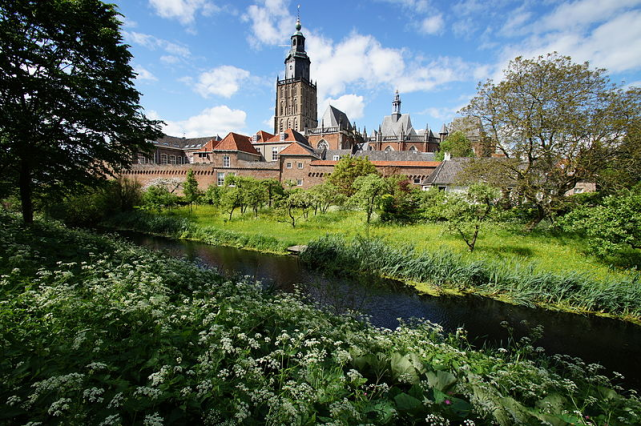
二、自然地理
Zutphen is a city and municipality located in the province of Gelderland, Netherlands. It lies some 30 km northeast of Arnhem, on the eastern bank of the river IJssel at the point where it is joined by the Berkel. First mentioned in the 11th century, the place-name appears to mean "south fen" (zuid-veen in modern Dutch). In 2005, the municipality of Zutphen was merged with the municipality of Warnsveld, retaining its name. In 2019, the municipality had a population of 47,609.
Transport
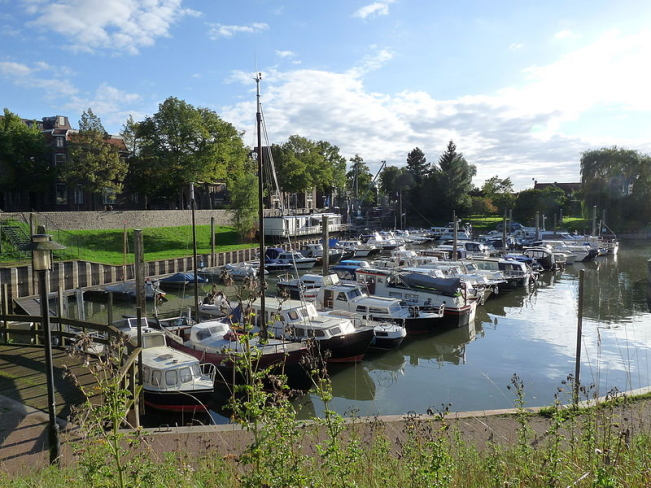
Port of Zutphen
Rail
Zutphen railway station is an important regional railway centre. The main electrified lines, to Deventer and Zwolle in the north, and to Arnhem and Nijmegen in the south, are run by the national railway company Nederlandse Spoorwegen (NS). The secondary lines to Winterswijk and Apeldoorn are operated by Arriva. The secondary line to Hengelo is operated by Blauwnet (a division of Syntus). The regional rail service is run by a special subsidiary of the NS. All secondary lines run diesel trains. Zutphen's old station building (1863), upgraded in 1875, was partly destroyed during World War II. In the early 1950s a modern new station was built, a typical post-war building with concrete as its main material.[6] However, in October 2007 the station building was designated as a State Monument. In 2006 and 2007, the area surrounding the railway station was completely renovated: a new bus terminal and an underground bicycle parking lot were constructed, and the main road leading from the railway station to the town centre was turned into a road for pedestrians and cyclists only.
Road
Zutphen lies 10 kilometers south of the A1 motorway, which can be entered where it passes Deventer. From there the A1 leads East to Hengelo and West past Apeldoorn to Amsterdam. Main roads are the N348 (Arnhem to Zutphen, Deventer and Ommen), N314 (Zutphen to Doetinchem), N319 (Zutphen to Vorden and Winterswijk), N345 (Zutphen to Lochem and Hengelo), N826 (Zutphen to Almen and Laren).
Bus
Almost all buses in and around Zutphen are operated by Arriva. There are three internal city bus lines, and regional lines to Doetinchem, Deventer, Almen-Laren and Vorden. The bus lines towards Apeldoorn and Dieren were cancelled in the past; these towns and the destinations in between can now only be reached by car or by train.
三、经济发展和规模
Zutphen offers a large industrial estate by the river, to the west of the town centre, with its own modern inland shipping port. The most important industrial sectors represented in the area are printing and publishing, and the metal industry.
Reference: https://www.hanse.org/en/hanseatic-cities/zutphen
Zutphen - Average purchase price 266,585.00 Euro in 2019
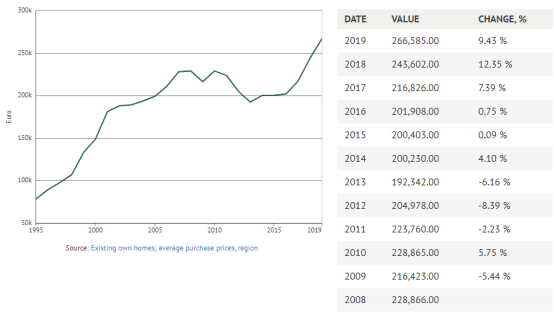
Total dwellings - Zutphen - Average consumption of natural gas
1,280.00 m3 in 2018
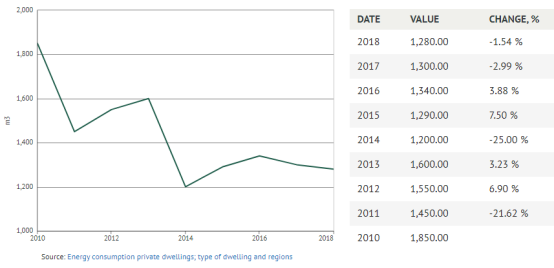
Reference: https://knoema.com/search?query=Zutphen%20gdp
四、产业特点/重点项目
River in the City
River in the City consists of several projects for a better connection between the Zutphen city center, the IJssel and De Hoven. The aim: a beautiful and (water) safe city, with plenty of space for recreation and tourism.
The map shows an overview of the projects. Below you can click through to more information about the projects that we are preparing, that are in progress or are already finished.
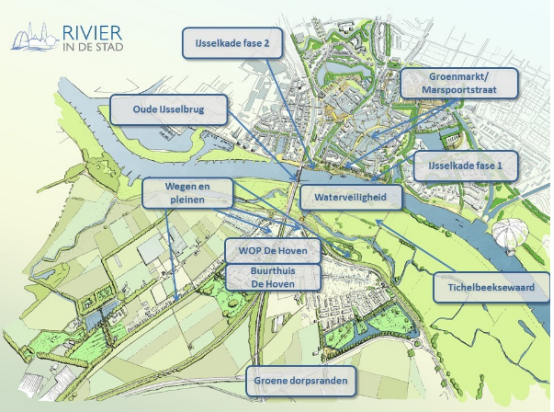
Quay wall is visible again
For years, an ancient wall was hidden underground in Zutphen aan de Rijkenhage. We make this wall visible again and will be restored.
After the restoration, the wall is the quay of De Berkel and the departure point for the whisper boats. The immediate vicinity is being refurbished and the adjacent Berkel ruin will be provided with sustainable lighting. With this we preserve the cultural-historical heritage in Zutphen and give Zutphen's history more publicity.
Schedule
Work started in May 2020. After clearing the monastery walls, it was found that these walls are insufficiently founded. A solution is currently being worked on. Delivery is in the fall of 2020.
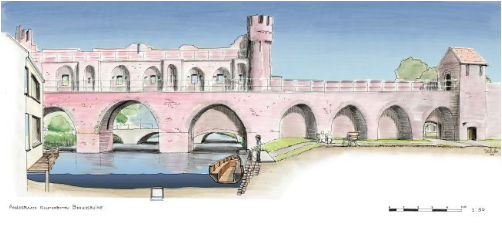
Fiberglass construction
We are regularly asked when fiber is being installed in the neighborhoods.
On the basis of European and national legislation, municipalities have a very limited role in the construction of optical fiber. It is basically completely left to the market. However, there is a difference between areas where fast internet (at least 100 MB per second) is offered (the so-called 'black' areas) and areas where less than 30 MB per second is offered (the 'white' areas).
Redesign Deventerweg
We are going to redesign the Deventerweg. It concerns the section between the Van der Capellenlaan and the roundabout at the Coehoornsingel. The speed of car traffic must decrease and the road must become safer for cyclists. The pavement itself is also being renewed. Maintenance of the road is also necessary and the sewer must be replaced.
College approved the design
On 5 November 2019, the Commission decided to agree to the design and implementation of the "Reconstruction Deventerweg" project, provided that the Council makes additional credit available.
The Commission decides to propose to the Council that an additional credit of € 437,000 be made available for the implementation of this project and that this be covered from the capital costs recognized in the program budget 2020-2023. The council will discuss the college's proposal in December 2019. The council then decides whether more money will be made available for the realization of the design.
The main reasons that more money is needed for the redesign of the Deventerweg:
The sharp price increases in the construction sector since 2016.
A sustainable landscaping was chosen. There will be a double row of trees. A large part of the trees remain. It has been decided to gradually replace the Lindes with other trees in the coming years. The new trees will have a soil supply for a long life (about 80 years).
80 homes will be built on the former sports grounds of the youth prison grounds. The name of the plan is Hof van Wesse.
The housing supply is very diverse. There are 2-storey terraced houses with a flat roof or a pointed roof and 12 semi-detached houses. All homes have since been sold. Construction is still in full swing. The first homes have now been completed. After the summer, all homes are ready.
More information: https://www.facebook.com/HofvanWesseZutphen/
New construction Park Helbergen
Local residents and other residents involved have worked together with the municipality on the interpretation of Park Helbergen. This area is located between the Vierakkerse Laak, the IJsseldijk, the Waarden and the Laan naar Eme.
Park Helbergen is divided into 3 areas:
North side: housing construction
Middle part: green zone
South side: temporary use, later housing
You can find more information about the developments at Helbergen Park (including images, newsletters and other documents) on the Park Helbergen.nl website . Information about the sale of the lots in the northern part: www.tenhag.nl
New construction Leesten-Oost
In Leesten-Oost, owner-occupied and private sector rental properties are being built. There is a wide variation in type housing and in price ranges.
The Leesten district is located on the east side of the city. The district consists of two parts, Leesten-West, which has already been completed, and Leesten-Oost, which is still under development.
Houses are being built with a wide variety: terraced houses, semi-detached houses, detached houses, project-based and in private commissioning. More information about the district and the houses can be found on the website Leesten is top.nl and on Nieuwbouw-leestenoost.nl .
Area plan rural area
In 2015, the vision 'Rural Area, living and doing business in a varied landscape' was adopted. With this vision we want to indicate how we will deal with the rural area within our municipality in the future. An elaboration of the vision is the Landscaping Area Plan.
五、风景名胜,景点
Because Zutphen contains a large number of historical buildings with a tower, Zutphen is often called the tower city. Because there are almost no modern high-rise buildings in the city centre the historical tower spires are very visible and form the skyline of Zutphen. The title of tower city is often used in advertising to draw tourists to Zutphen.
Religious architecture
The Walburgis church was built as a Roman collegiate church around 1050, after that it was redecorated, rebuild and remodeled on several occasions. There are six bells in the tower, which are still rung by hand.
Since 1561 a library called the Librije was added to the church. It was founded as a public library for the rich citizens of Zutphen. These days the library contains an important collection of 15th- to 17th-century books.
The Broederen (brothers) church is a large early 14th-century monastery church of the Dominican order. Since 1983 the church has been used as the city's public library, and it was recently been extensively restored. On top of the church there is a roof turret from 1771 that contains the porter's bell. This bell is still rung every day between 9:50 and 10:00 pm, the time at which, until 1853, the city gates would be closed.
The Nieuwstads (new city) church houses the Catholic community. It was founded as a parish church around 1250. Since then it has been expanded, remodelled and restored many times. It has four original medieval bells.
Civic architecture
The Drogenaps tower was built between 1444 and 1446 as a city gate. In 1465 the entrance was bricked up after which it became known as a tower instead of a gate. City musician Tonis Drogenap lived there around 1555 and the tower's current name is derived from him. From 1888 till 1927 the tower was used as a water tower.
The Wijnhuis (Winery) Tower was built between 1618 and 1642 by the city master builder Emond Hellenraet, influenced by Hendrick de Keyser. In 1644 the brothers Pieter and François Hemony made the world's first correctly tuned carillon for this tower. During the summer months carillon concerts are regularly held.
The Bourgonje tower is a defensive turret build in 1457. It was built during the Gelderland-Burgundian war. The Dutch theologian and philosopher Johannes Florentius Martinet wrote his Katechismus der Natuur (Catechism of Nature) in this tower.
The Berkel gate is part of the city wall on the east side of the medieval city. This gate over the river Berkel connected the old city and the new city. It was built in 1320. It also had a western counterpart but that gate was demolished in 1772.
Other interesting sights in Zutphen
The city of Zutphen had almost 400 national monuments and over 500 local monuments. It is one of the most important and well-preserved historical city centres in the Netherlands. Zutphen has a great many medieval, especially 14th-century, houses. These houses, often with ornamental facades, can be spotted all through the city centre.
When walking along the old city market you will see several large 18th- and 19th-century buildings that used to belong to well-to-do citizens and merchants.
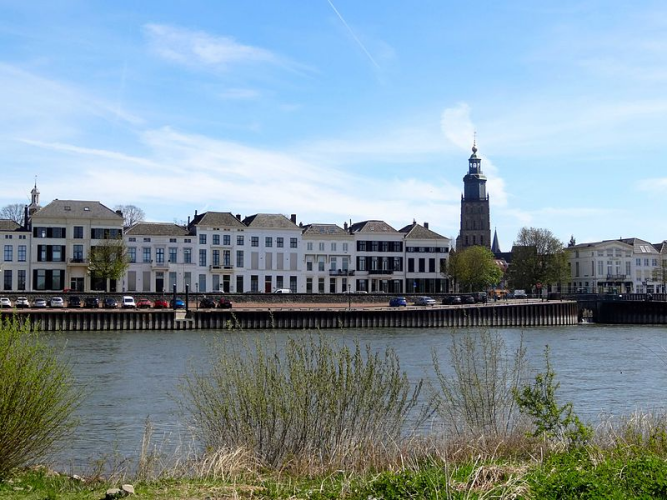
The IJssel river in Zutphen
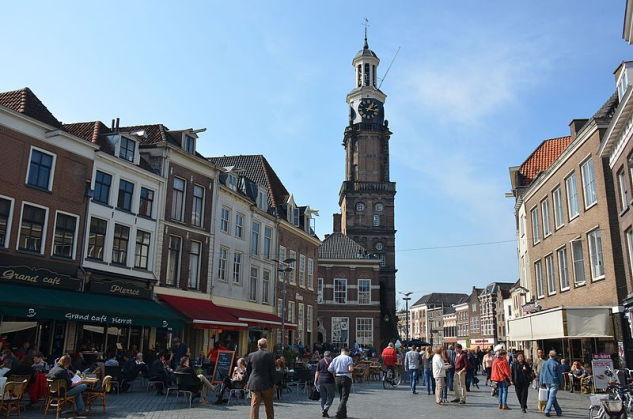
Zutphen's old city centre
六、历史文化
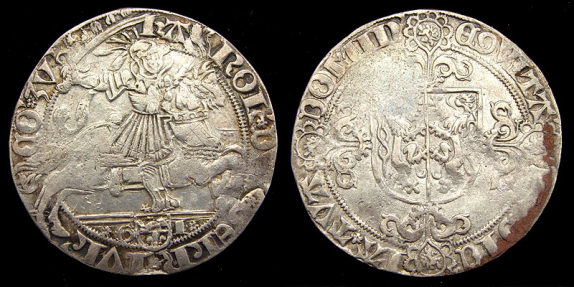
"Snaphaanschelling" struck in Zutphen
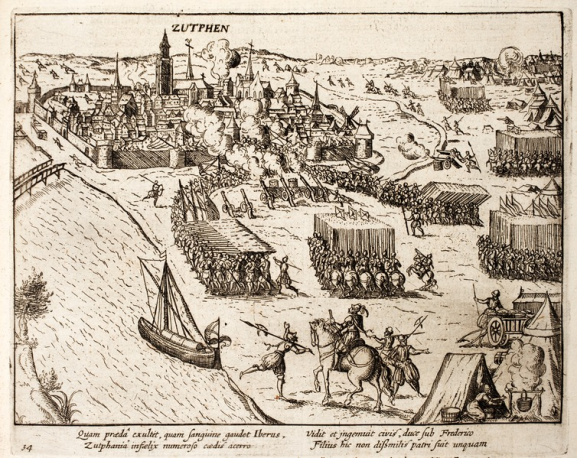
1649 map of Zutphen in Willem and Joan Blaeu's "Toonneel der Steden"
Zutphen (1654)
In about 300 AD, a Germanic settlement was the first permanent town on a complex of low river dunes. Whereas many such settlements were abandoned in the early Middle Ages, Zutphen on its strategic confluence of IJssel and Berkel stayed. After the incorporation of the IJssel lands in Charlemagne's Francia, Zutphen became a local centre of governance under a count. The Normans raided and ravaged it in 882. Afterwards a circular fortress was built to protect the budding town against Viking attacks.
In the eleventh century, Zutphen was a royal residence for a number of years; a pfalz was built, together with a large chapter church, the predecessor of the present St. Walburgis. The counts of Zutphen acquired a lot of power, until the line of counts became extinct in the twelfth century. After the death of her father and her brother, Ermengarde, the heiress of Zutphen married the count of Guelders; her son Henry I, Count of Guelders was the first to wear both titles.
The settlement received town rights between 1191 and 1196, making it one of the oldest towns in the country. This allowed it to self govern and have a judicial court. Only Utrecht, and Deventer preceded it in receiving town rights. Zutphen, in turn, became the mother town of several other towns in Guelders, such as Arnhem, Doetinchem, Doesburg, Lochem, Harderwijk, Venlo and Emmerich. It also became part of the Hanseatic League, a group of towns with great wealth; this league was the economic centre in that part of Europe.
During the 12th century, coins were minted in Zutphen by the Counts of Guelders and Zutphen: Henry I (c. 1150–1181) and Otto I (1182–1207). Although the city had minting rights for a few centuries this was only actively used during four periods: 1478–1480, 1582–1583, 1604–1605 and 1687–1692.
The largest and oldest church of the city is the St. Walburgis (Saint Walpurga) church, which originally dates from the eleventh century. The present Gothic building contains monuments of the former counts of Zutphen, a fourteenth-century candelabrum, an elaborate copper font (1527), and a monument to the Van Heeckeren family (1700). The chapter-house's library (Librije [nl]) contains a pre-Reformation collection, including some valuable manuscripts and incunabula. It is considered one of only five remaining medieval libraries in Europe (the others being in England and Italy). This chained library's books are still chained to their ancient wooden desk – a custom from centuries ago, when the "public library" used chains to prevent theft.
Having been fortified the town withstood several sieges, specially during the Eighty Years' War, the most celebrated fight under its walls being the Battle of Zutphen in September 1586 when Sir Philip Sidney was mortally wounded. Taken by the Spanish in 1587 by the treachery of the English commander Rowland York, Zutphen was recovered by Maurice, prince of Orange, in 1591, and except for two short periods, one in 1672 and the other during the French Revolutionary Wars, it has since then remained a part of the Netherlands. Its fortifications were dismantled in 1874. In World War II the town was bombed several times by the allied forces because the bridge over the IJssel was vital to support the German troops at Arnhem after the Operation Market Garden. After two weeks of battle the town was liberated on 14 April 1945. After the war a renovation program started. Nowadays Zutphen has one of the best preserved medieval town centres of northwestern Europe, including the remains of the medieval town wall and a few hundred buildings dating from the 13th, 14th and 15th centuries.
七、其他信息
Juridical centre
Zutphen, although a relatively small town, houses one of the Netherlands' 13 courts, the national training institution for judges and public prosecutors (SSR), the national police academy for senior police investigators, three prisons and a large number of lawyers. It is the early emergence of Zutphen in the Middle Ages as the main town of a county that explains its current position in the juridical system.
Besides a 'normal' prison, one may find in Zutphen the JPC de Sprengen penitentiary facility for boys. There are several buildings: new institutions replacing the old facilities, but the old prisons remained open after completion of the new facilities. Only the old prison called Lunette did not meet today's standards and has closed in 2008.
Medical centre
Located in Zutphen is the "Spittaal", location of the Gelre Ziekenhuizen (Gelre Hospitals) group. This is a regular hospital offering all common specialities (no cardio-thoracic or neurosurgery) and a 24/7 emergency department. It is located in the southeastern part of the town, in the district of Leesten. A sizable number of practitioners of alternative medicine are located in Zutphen.
Educational centre
Zutphen is home to several well-known schools for secondary education on all levels. These include the "Het Stedelijk" (Dalton plan education and bilingual education), "Baudartius College", "Vrije School Zutphen", (a "Vrije School" being a Waldorf School) and "Isendoorn College" (with bilingual education,located in Warnsveld). Students from a wide area around Zutphen learn at these schools.
八、联系方式
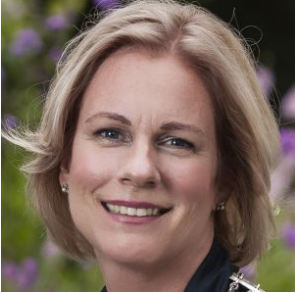
Mayor Annemieke Vermeulen (VVD)
Born: August 15, 1964 (age 55 years), Apeldoorn, Netherlands
Email: Burgemeester@zutphen.nl
Address: Box 41, 7200 AA Zutphen's Gravenhof 2
Phone 14 0575
https://www.zutphen.nl/
